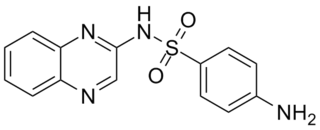
Boca Raton, is a city in southern Palm Beach County, Florida. It was first incorporated on August 2, 1924, as "Bocaratone," and then incorporated as "Boca Raton" in 1925. The 2019 population estimated by the U.S. Census Bureau was 99,805. However, approximately 200,000 additional people with a Boca Raton postal address live outside of municipal boundaries, such as in West Boca Raton. As a business center, the city experiences significant daytime population increases. Boca Raton is 45 miles (72 km) north of Miami and is a principal city of the Miami metropolitan area, which had a population of 6,012,331 people as of 2015. It is known as one of the wealthiest places in South Florida.

Di-tert-butyl ether is a tertiary ether that is used as a solvent.

Caesium hydroxide or cesium hydroxide (CsOH) is a chemical compound consisting of caesium ions and hydroxide ions. It is a strong base, much like the other alkali metal hydroxides such as sodium hydroxide and potassium hydroxide. In fact, caesium hydroxide is corrosive enough to dissolve through glass quickly.
2-Chlorophenol or ortho-chlorophenol is an organic compound with the formula C6H4Cl(OH). It is one of three isomeric monochloride derivatives of phenol. As from occasional use as a disinfectant, it has few applications. It is an intermediate in the polychlorination of phenol. 2-Chlorophenol is a colorless liquid, although commercial samples are often yellow or amber-colored. It has an unpleasant, penetrating (carbolic) odor. It is poorly soluble in water.

Trichloroacetyl chloride is the acyl chloride of trichloroacetic acid. It can be formed by reacting chlorine with acetyl chloride or acetaldehyde in the presence of activated charcoal. It is used in the manufacture of pharmaceuticals and plant protection compounds.
Yttrium(III) sulfide (Y2S3) is an inorganic chemical compound. It is a compound of yttrium and sulfur.
James A. Duke was an American botanist. He was the author of numerous publications on botanical medicine, including the CRC Handbook of Medicinal Herbs. He was well known for his 1997 bestseller, The Green Pharmacy. He developed the Dr. Duke's Phytochemical and Ethnobotanical Databases at the USDA.
Pinacolyl alcohol is a common name for 3,3-dimethyl-2-butanol, also known as pine alcohol. Pinacolyl alcohol's molecular formula is C6H14O and it is a secondary alcohol.

3-Pentanol is one of the isomers of amyl alcohol.
2-Heptanol is a chemical compound which is an isomer of heptanol. It is a secondary alcohol with the hydroxyl on the second carbon of the straight seven-carbon chain.
Dipropylamine is a flammable, highly toxic, corrosive amine. It occurs naturally in tobacco leaves and artificially in industrial wastes. Exposure can cause excitement followed by depression, internal bleeding, dystrophy, and severe irritation.

Sulfaquinoxaline is a veterinary medicine which can be given to cattle and sheep to treat coccidiosis. It is available in Pakistan with Sanna Laboratories in combination with Amprolium and Vitamin K as potential treatment of coccidiosis.

2-Methyl-1-butanol is an organic compound with the formula CH3CH2CH(CH3)CH2OH. It is one of several isomers of amyl alcohol. A colorless liquid, it occurs naturally in trace amounts and has attracted some attention as a potential biofuel, exploiting its hydrophobic (gasoline-like) and branched structure. It is chiral.

2-Pentanol is an organic chemical compound. It is used as a solvent and an intermediate in the manufacturing of other chemicals. 2-Pentanol is a component of many mixtures of amyl alcohols sold industrially. 2-Pentanol is chiral and thus can be obtained as either of two stereoisomers designated as (R)-(−)-2-pentanol and (S)-(+)-2-pentanol.

3-Hexanol is an organic chemical compound. It occurs naturally in the flavor and aroma of plants such as pineapple and is used as a food additive to add flavor.

4-Methyl-2-pentanol or methyl isobutyl carbinol (MIBC) is an organic chemical compound used primarily as a frother in mineral flotation. It is also used as a solvent, in organic synthesis, and in the manufacture of brake fluid and as a precursor to some plasticizers.

2-Ethyl-1-butanol is an organic chemical compound. It can be used to facilitate the separation of ethanol from water, which form an azeotrope that otherwise limits the maximum ethanol concentration.
3-Methyl-2-butanol is an organic chemical compound. It is used as a solvent and an intermediate in the manufacture of other chemicals.













